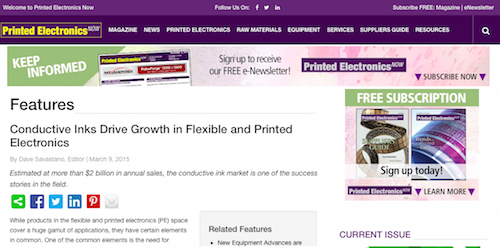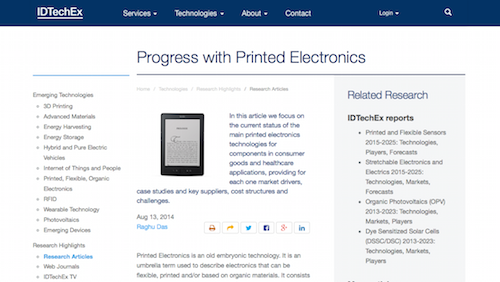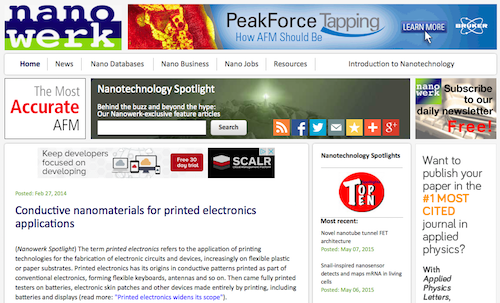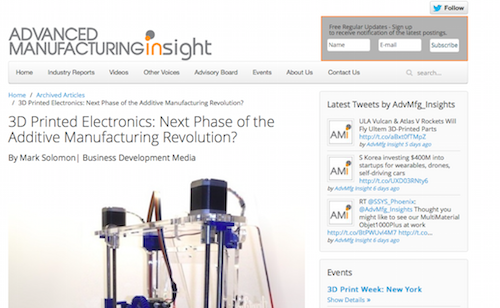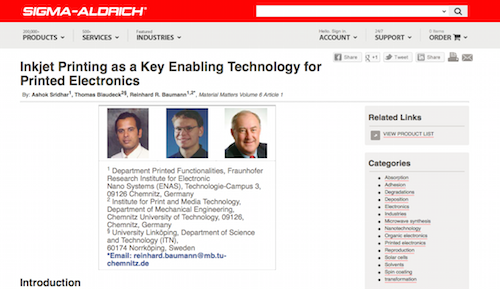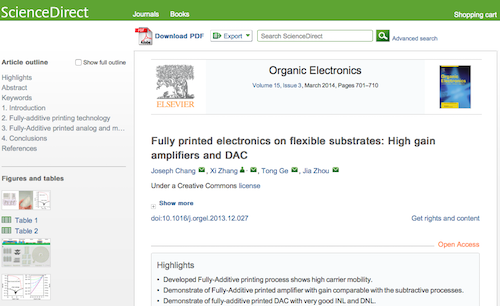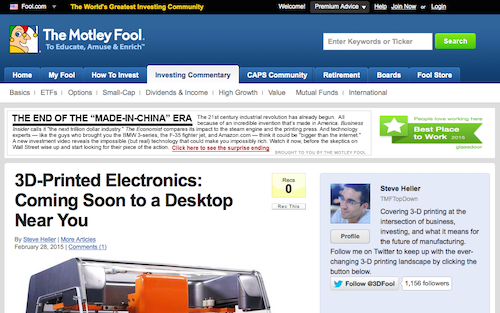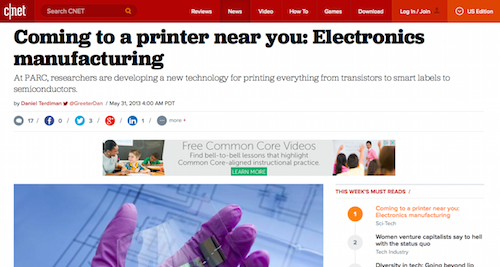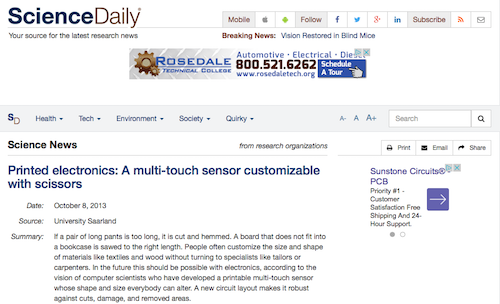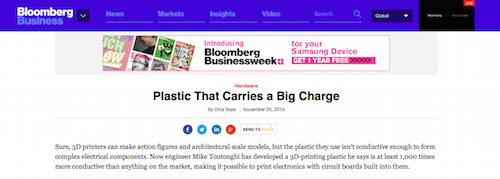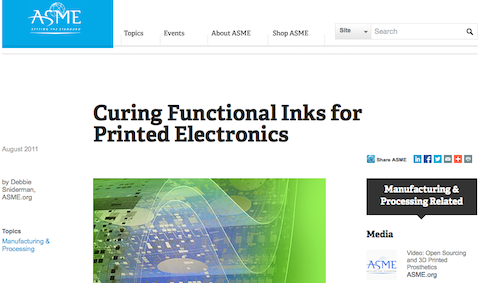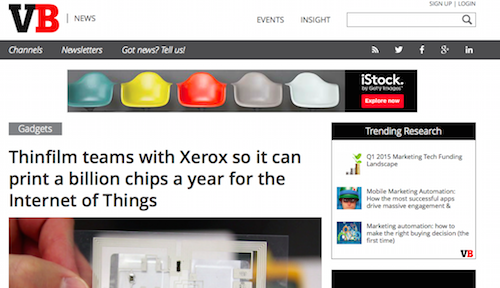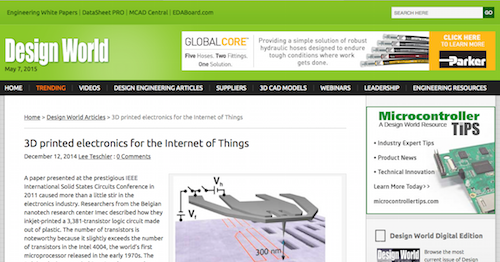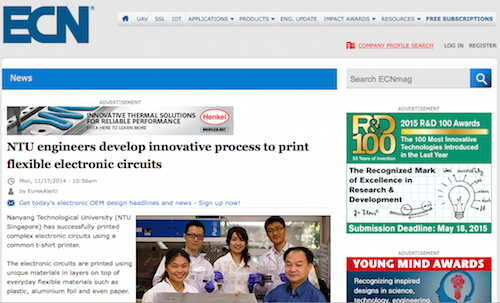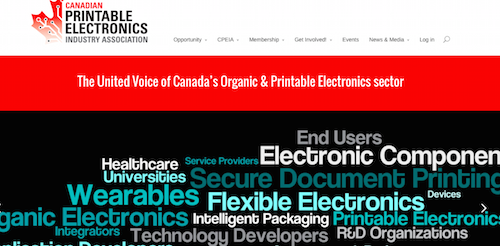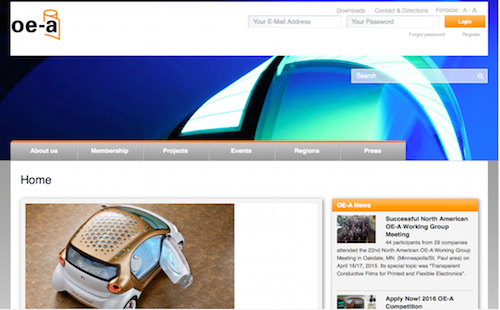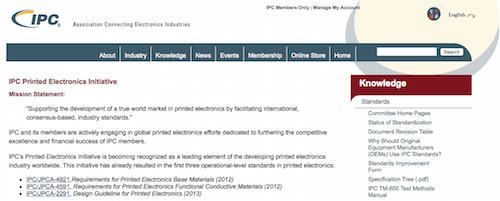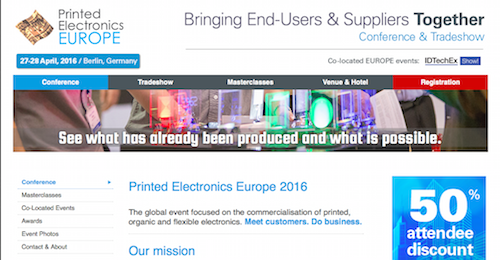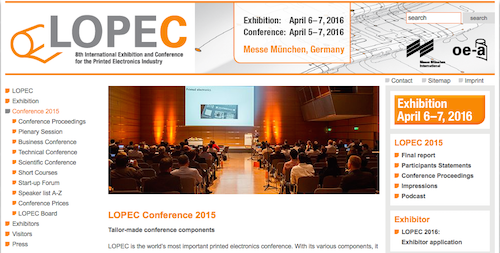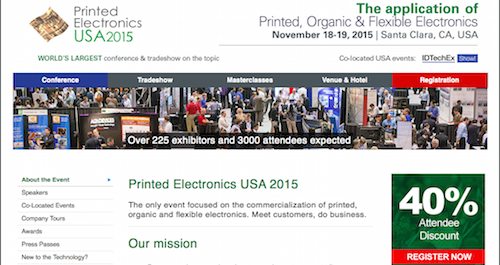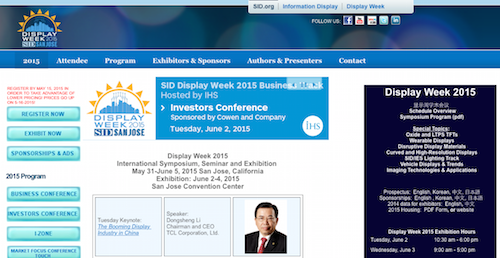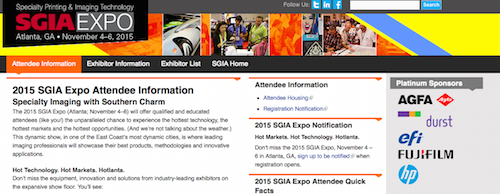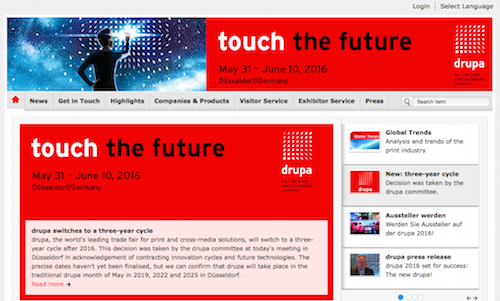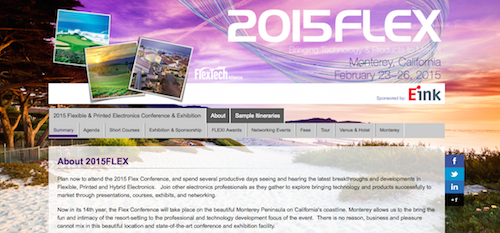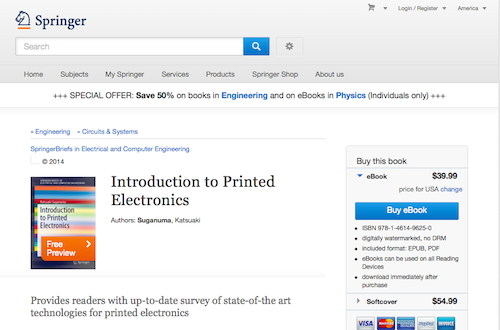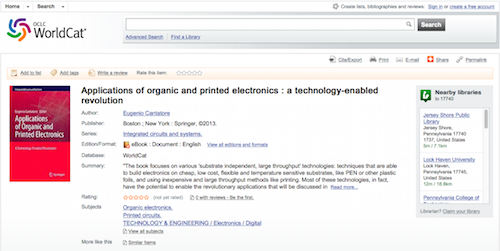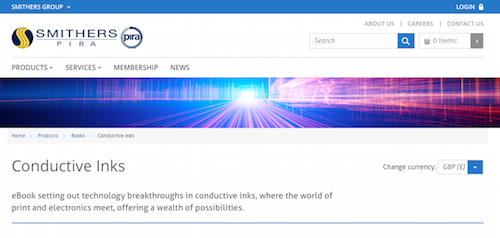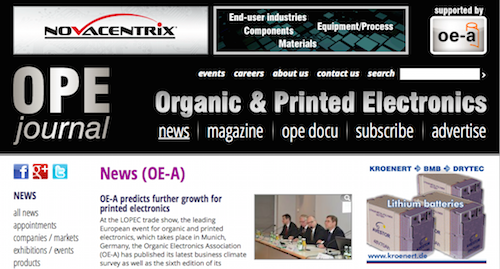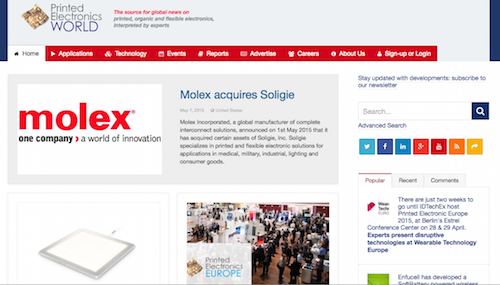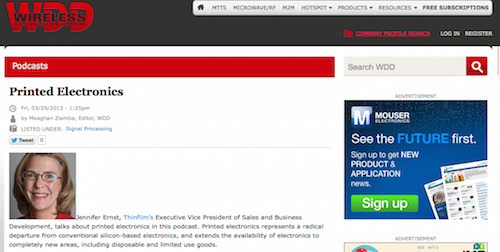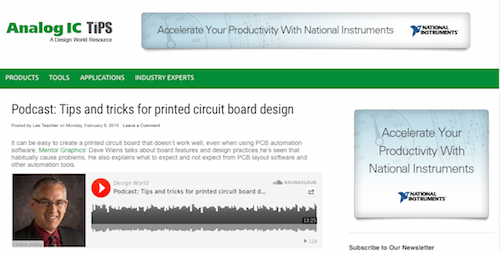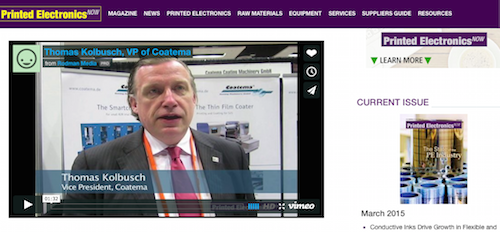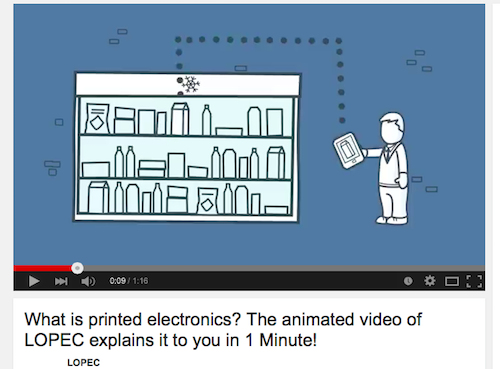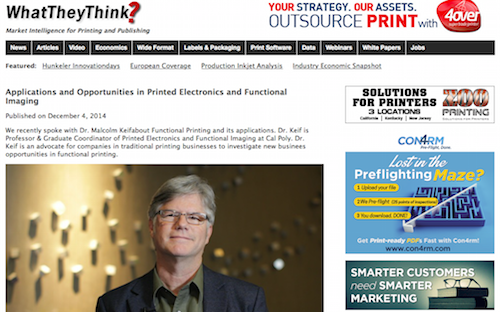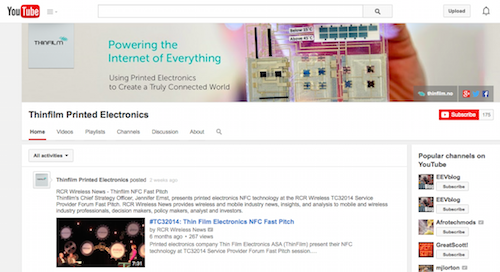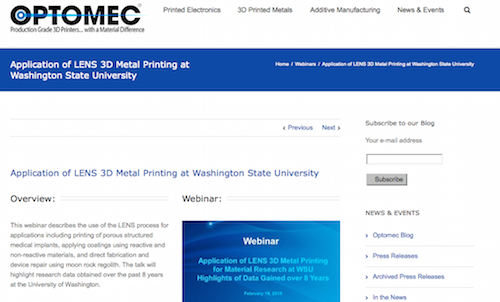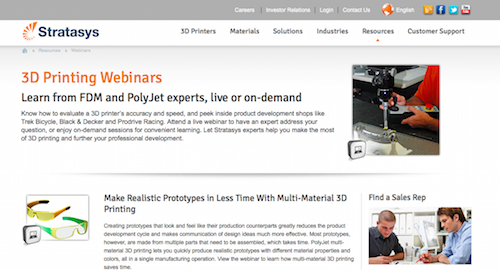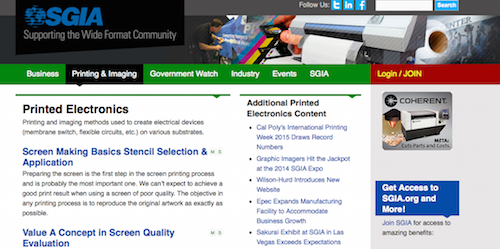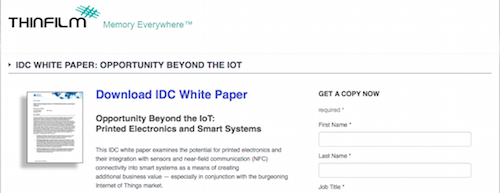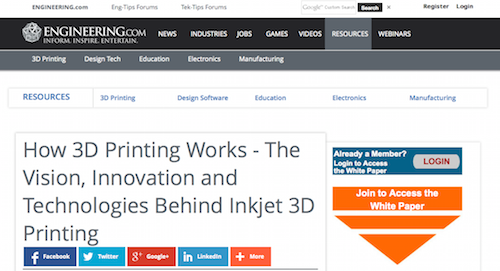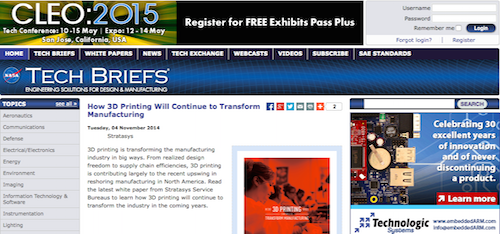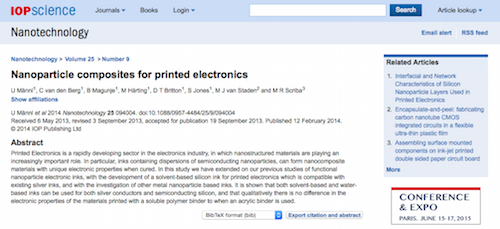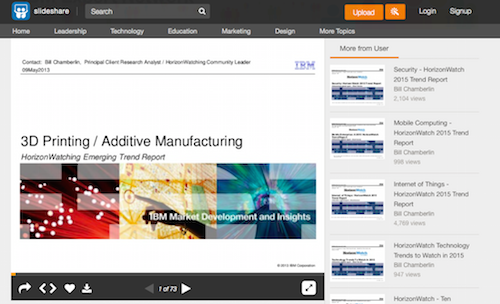Printed electronics refers to the application of printing technologies for fabricating electronic circuits and devices. Increasingly, printed electronics also encompasses flexible plastic or paper substrates. Printed electronics originated in conductive patterns printed as part of conventional electronics to form flexible keyboards and antennas, and then evolved to include fully printed testers on batteries, electronic skin patches, and other devices made entirely by printing. Now, inkjet printing delivers printed electrical circuits quickly and cheaply.
The printed electronics field and market are growing, and it is important to understand where the field has been and where it is going. Specifically, as the demand for flexible and wearable devices and applications increases, printed electronics is rapidly evolving and expanding to meet those demands. Advancements in printed electronics are occurring, and it is important to stay up to date with the latest trends and news in the field. That’s why we at Pannam have searched for authoritative printed electronics resources from industry leaders and experts.
Below you will find articles, associations, conferences, symposiums, forums, eBooks, journals, online magazines, podcasts, videos, webinars, and white papers covering every aspect of printed electronics. We have included a table of contents to make it easier for you to jump to the resources categories that most interest you.
Please keep in mind that we have listed our top printed electronics resources in no particular order.
Jump to:
- Articles
- Associations
- Conferences, Symposiums, and Forums
- eBooks
- Journals and Online Magazines
- Podcasts, Videos, and Webinars
- White Papers, Scholarly Papers, and Reports
Articles
1. Conductive Inks Drive Growth in Flexible and Printed Electronics
@PE_Now
Dave Savastano, Editor of Printed Electronics Now, wrote this article describing how the conductive ink market is a successful aspect of the printed electronics industry, with annual sales to be at more than $2 billion. Savastano features Dr. Khasha Ghaffarzadeh, head of consulting for IDTechEx, in the article, and Dr. Ghaffarzadeh predicts the “market is set to grow to nearly $3.2 billion in 2025, registering a CAGR of 3.26% over the decade.”
Three key ideas we like from Conductive Inks Drive Growth in Flexible and Printed Electronics:
- PE applications ranging from sensors to solar, touch screens and displays, to near field communication (NFC) and printed RFID tags, among others, utilize conductive materials
- Printing edge electrodes for touch screens is also a growing sector
- The flexible and printed electronics markets also are growing, with more PE applications reaching the pilot production and manufacturing stages
Cost: FREE
2. Progress With Printed Electronics
@IDTechEx
IDTEchEx conducts impartial market research, business intelligence, and events on emerging technologies such as printed electronics, the Internet of Things (IoT), 3D printing, and others. This article discusses the current state of major printed electronics technologies for components in consumer goods and healthcare applications.
Three key ideas we like from Progress With Printed Electronics:
- AC Electroluminescence is being used in labels and promotional materials as well as on wearables
- Thin film batteries, including flexible and curved batteries, are being driven by the wearable electronics market
- Glucose test strips using printed conductor electrons on each strip has been a major success and is a multi-billion dollar market
Cost: FREE
3. Conductive Nanomaterials for Printed Electronics Applications
@Nanowerk
Nanowerk deals with nanotechnology and emerging technologies. Their article, Conductive Nanomaterials for Printed Electronics Applications, addresses the requirements and challenges for printable dispersions of conductive nanomaterials and applications of conductive nanomaterials in relation to the printed electronics market.
Three key ideas we like from Conductive Nanomaterials for Printed Electronics Applications:
- Using nanomaterials for the formulation of conductive inkjet inks poses several challenges, including stability and the ability to provide good electrical conductivity of printed patterns
- There are several applications of conductive nanomaterials for fabricating printed electronics, including fabrication and properties of transparent conductive electrodes
- There is a focus on graphene and future developments in printed electronics that combine conductive nanomaterials with graphene are expected
Cost: FREE
4. 3D Printed Electronics: Next Phase of the Additive Manufacturing Revolution?
@AdvMfg_Insights
Advanced Manufacturing Insight is a publication from Business Development Media that delivers information regarding the most advanced thinking on real-world manufacturing problems and innovative solutions. This article explains that the boom in 3D printer company revenues supports “all of the early hype about 3D printing” and outlines the expectations surrounding the next phase of 3D printing development, the functional circuits being built in layers using variants on basic 3D printing principles and platforms.
Three key ideas we like from 3D Printed Electronics: Next Phase of the Additive Manufacturing Revolution?:
- 3D electronic printing functions much like 2D printing, with the advantage of being able to produce 3D objects with embedded wires and circuitry
- There are several 3D conductive/electrical printing technologies vying for commercial success, including filament base with inkjet-applied conductive inks and gels and graphene substrate and conductor
- The advantages of 3D printed electronics are numerous, including complex geometries, aerospace parts with embedded radiation shielding plastics, and mass customization for biomedical companies making perfect copies of anatomy
Cost: FREE
5. Inkjet Printing as a Key Enabling Technology for Printed Electronics
@SigmaAldrich
This article by Ashok Sridhar, Thomas Blaudeck, and Reinhard Baumann explores how advancements in digital printing technologies have impacted printed electronics and are resulting in innovative fabrication approaches leading to lean manufacturing. The article also discusses the classification of inkjet printing technology, various relevant aspects regarding inks and substrates, and the possibilities surrounding inkjet-printed electronics.
Three key ideas we like from Inkjet Printing as a Key Enabling Technology for Printed Electronics:
- The progress of printed electronics has opened new possibilities in conception, design, fabrication, packaging, and application of electronic devices and circuits
- Some key factors that enable the deployment of printing processes in electronics fabrication include the additive nature of printing processes, the range of materials that can be formulated as inks, and the possibility to cater to various production scales, ranging from prototype to large-scale
- Screen printing and inkjet printing are the dominant printing technologies for printed electronics
Cost: FREE
6. Fully Printed Electronics on Flexible Substrates: High Gain Amplifiers and DAC
@sciencedirect
Science Direct is a full-text scientific database offering articles and chapters from more than 2,500 peer-reviewed journals and 26,000 books. This article is from Organic Electronics Volume 15, Issue 3, from March 2014 and was written by Joseph Chang, Xi Zhang, Tong Ge, and Jia Zhou, who propose “a novel simple fully-additive printing process involving only depositions for realizing printed electronics circuits/systems on flexible plastic films.”
Three key ideas from Fully Printed Electronics on Flexible Substrates: High Gain Amplifiers and DAC:
- The proposed fully-additive process is green, using non-corrosive chemicals, on-demand, scalable, and low cost
- The proposed fully-additive process features printed transistors with high semiconductor carrier mobility
- It is possible to realize complex circuits and systems on flexible plastic films with the proposed fully-additive process
Cost: FREE
7. A New Switching Device for Printed Electronics: Inkjet-Printed Microelectromechanical Relay
@ACSPublications
As the publisher of the most-cited, peer-reviewed journals in the chemical and related sciences, ACS Publications is a trusted source for printed electronics news. This article by Eung Seok Park, Yenhao Chen, Tsu-Jae King Liu, and Vivek Subramanian of the Department of Electrical Engineering and Computer Sciences at the University of California at Berkeley, discusses how printed microelectromechanical (MEM) switches represent a unique, attractive path for realizing printed electronics.
Three key ideas we like from A New Switching Device for Printed Electronics: Inkjet-Printed Microelectromechanical Relay:
- A key to realizing low-cost, large-area electronic systems is printed electronics that employ solution-processed materials
- Printed transistors sometimes are inadequate for most intended applications because of the limited performance of traditional printable semiconductor materials
- Building mechanical switches with printed metal nanoparticle-based inks, as in inkjet-printed MEM switches with abrupt switching characteristics, is a solution for realizing printed electronics
Cost:
- $35 for 48 hours of access
- ACS Members have additional access options
8. 3D-Printed Electronics: Coming Soon to a Desktop Near You
@3DFool
Steve Heller covers 3D printing and its impact on business, investing, and the future of manufacturing at The Motley Fool. In this article, he details a start-up named Voxel8 that debuted the worlds’ first 3D electronics printer that can 3D print objects featuring the ability to embed electronic components, 3D print conductive ink, and sit on a desk.
Three key ideas we like from 3D-Printed Electronics: Coming Soon to a Desktop Near You:
- Voxel8 marks a new era in product design that emphasizes designing electronics to fit a product, rather than designing products around their electronics
- Voxel8 enables engineers and product designers to 3D print objects as large as 4 x 6 x 4 inches in PLA plastic and conductive ink
- Autodesk offers Project Wire, a new kind of software suite that allows users to place components, route wires, and output multi-materials 3D printing data to the Volex8
Cost: FREE
9. Improved Solar Panels and Printed Electronics On the Horizon With New Discovery
@physorg_com
In this printed electronics article, David Scott shares news of a report published in Nature Communications by University of Melbourne researchers who discovered a new liquid crystal material that improves the performance of printable organic solar cells. The implications of the discovery could mean wider commercialization of printed organic solar cells and the development of new materials with improved performance such as LCD screens.
Three key ideas we like from Improved Solar Panels and Printed Electronics On the Horizon With New Discovery:
- The new discovery of the highly sought after nematic liquid crystals can lead to vastly improved organic solar cell performance, nearing the international benchmark of 10 %
- The organic models have an unparalleled versatility because they can be shaped to fit nearly any surface area
- Printable electronics as parts of phones and cars may be more possible and perform better with the new solar cells
Cost: FREE
10. Coming To a Printer Near You: Electronics Manufacturing
@GreeterDan
@CNET
This CNET article by Daniel Terdiman, a soon-to-be Fast Company senior writer who covers emerging technology, describes how researchers at the Palo Alto Research Center (PARC) are developing new technology for printing transistors, smart labels, and semiconductors, among other electronic components. The work also brings about a new element for 3D printing: adding electronic, sensing, or optical functionalities to parts.
Three key ideas we like from Coming To a Printer Near You: Electronics Manufacturing:
- The new system uses specially-developed inks to generate electronics from scratch
- PARC iw working in conjunction with private companies and academic institutions to break new ground in printable, functional electronics and to use the technology for functional products or prototypes
- Methods include printing electronics with traditional inkjet print heads and others such as gravure and flexo
Cost: FREE
11. Printed Electronics: A Multi-Touch Sensor Customizable With Scissors
@ScienceDaily
ScienceDaily delivers breaking news about the latest discoveries in science, health, the environment, and technology. This article, based on materials from University Saarland, describes work that was presented at the conference “User Interface and Technology” (UIST) in St. Andrews, Scotland, regarding a new sensor that makes every surface interactive, even if it is a watch wristband, a cloth, or wallpaper.
Three key ideas we like from Printed Electronics: A Multi-Touch Sensor Customizable With Scissors:
- Scientists from Saarbrücken, together with researchers from the MIT Media Lab, have developed a printable multi-touch sensor that allows anybody to alter its shape and size
- The new circuit layout makes the new sensor robust against cuts, damage, and removed areas
- Printed sensors are likely to be so inexpensive that multi-touch sensing capability could become an inherent part of materials
Cost: FREE
12. Plastic That Carries a Big Charge
@BW
Bloomberg Businessweek featured an article by Dina Bass on 3D printing plastic in November 2014. The article showcases engineer Mike Toutonghi, who developed a 3D printing plastic that “is at least 1,000 time more conductive than anything on the market, making it possible to print electronics with circuit boards built into them.”
Three key ideas we like from Plastic That Carries a Big Charge:
- Market opportunities are nearly endless for print electronics
- The material, F-Electric, is conductive enough for circuitry
- With more advanced 3D printers, F-Electric smartphones may be three to four years away
Cost: FREE
13. Curing Functional Inks for Printed Electronics
@ASMEdotorg
ASME promotes multidisciplinary engineering and allied sciences around the world. This article explains how the inks and coatings, or functional inks, form a non penetrating, non permeable film that provides a finer resolution, thinner layers, better adhesion, and mechanical flexibility.
Three key ideas we like from Curing Functional Inks for Printed Electronics:
- Various scientists and companies have developed ways to handle the challenges posed by curing inks, including adjusting curing time, power, temperature, lamp frequencies, and other process conditions that are dependent on the specific film stack
- It is difficult to develop a single curing process because different standards govern inks used for printing electronic circuits in different industry sectors
- The processing tools must be compatible with high-speed printing processes
Cost: FREE
14. Thinfilm Teams With Xerox So It Can Print a Billion Chips a Year for the Internet of Things
@deantak
@VentureBeat
VentureBeat delivers the news that matters to the tech business world. This article by Dean Takahashi, a tech journalist with more than 25 years experience, explains that Thinfilm and Xerox are working together to mass produce printed electronics. Thinfilm will print as many as a billion chips a year for processors, memory, and sensors for the Internet of Things.
Three key ideas we like from Thinfilm Teams With Xerox So It Can Print a Billion Chips a Year For the Internet of Things:
- Commercializing printed electronics could mean an enormous number of disposable goods with intelligence
- Thinfilm’s smart labels for packages could sense and store data for a tenth to a hundredth the cost of conventional electronics
- Thinfilm Memory Labels are rewritable memory chips that can be used as labels on food or other packaged goods, replacing the traditional bar code
Cost: FREE
15. 3D Printed Electronics for the Internet of Things
@DesignWorld
Design World articles are written by industry experts who cover design engineering news, products, and tech for design engineers and engineering professionals. The 3D Printed Electronics for the Internet of Things article, written by Lee Teschler, explores the trend of developments in plastic circuits and the belief that printed electronics is an exponential technology.
Three key ideas we like from 3D Printed Electronics for the Internet of Things:
- Some technologists think the dimensions of plastic printed electronics will shrink in an exponential manner
- Plastic electronics cost much less to build because most plastic circuit fabrication utilizes straight-forward printing through ink jetting and processing with relatively inexpensive liquids
- Plastic printed transistors may be a key enabling technology for wearable electronics and other innovations that are critical to the Internet of Things
Cost: FREE
16. NTU Engineers Develop Innovative Process to Print Flexible Electronic Circuits
@ecnonline
Serving the electronic design community, ECN magazine reported on the Nanyang Technological University (NTU Singapore) engineers who successfully printed complex electronic circuits using a common T-shirt printer. The researchers contend their printing technique makes mass production of cheap disposable electronic circuits possible.
Three key ideas we like from NTU Engineers Develop Innovative Process to Print Flexible Electronic Circuits:
- The process will allow for smarter products, such as cartons that can tell when the milk expires, bandages that give redressing alerts, and smart patches that monitor health, such as heart rates
- The key difference between the NTU method and other types of printed electronics is that it is fully additive, which makes it eco-friendly; the circuits are printed entirely without the use of any toxic chemicals or oxidizing agents
- The four-person multi-disciplinary team looks to move forward by developing digital and analog printable circuits for other biomedical applications in sensing and processing
Cost: FREE
Associations
17. Canadian Printable Electronics Industry Association
@CPEIA_ACEI
The Canadian Printable Electronics Industry Association (CPEIA) represents the united voice of Canada’s organic and printable electronics sector. CPEIA brings together key Canadian and international players in industry, academia, and government to build a strong Canadian printed electronics sector.
Three key resources we like from Canadian Printable Electronics Industry Association:
- Industry News
- Events
- Printable Electronics Applications
Cost:
- Full Membership
- Multinationals: $500/year
- SMEs: $250/year
- Associate Membership
- International: $750/year
- Investment firms: $250/year
- Universities/R&D: $250/year
- Service providers: $250/year
- Individuals & Entrepreneurs: $100/year
- Students: $50/year
18. Organic Electronics Association (OE-A)
@OEAonline
The Organic Electronics Association (OE-A) is the leading international industry association for organic and printed electronics, representing the entire value chain of the industry. Members of OE-A include word-class global companies and institutions and range from R&D institutes, component and material suppliers, to producers and end users. Encompassing companies from Europe, North America, Asia, and Australia, OE-A works to establish a competitive production infrastructure for organic and printed electronics.
Three key resources we like from Organic Electronics Association:
- Working group meetings and calendar of events
- Training and education
- OE-A Roadmap for Organic and Printed Electronics
Cost:
- Class 0, 1-9 employees: €1200 annual dues
- Class I, 10-99 employees: €2500 annual dues
- Class II, 100-999 employees: €5000 annual dues
- Class III, 1,000-9,999 employees: €7500 annual dues
- Class IV, 10,000+ employees: €12500 annual dues
- Class U, Universities: €500 annual dues
- Class FI, Research institutes: €1500 annual dues
- Class C, Consultants: €12500 annual dues
19. IPC
@IPCassociation
IPC is a leading source for electronics industry standards, training, market research, and public policy advocacy. The IPC Printed Electronics Initiative features IPC and its members actively engaging in global printed electronics efforts to further the competitive excellence and financial success of IPC members. The initiative is recognized as a leading element the of developing printed electronics industry worldwide and has resulted in three operational-level standards in printed electronics. The IPC Printed Electronics Initiative also includes seven standards development committees working on printed electronics standards.
Three key resources we like from IPC:
- Requirements for Printed Electronics Base materials
- Requirements for Printed Electronics Functional Conductive Materials
- Design Guideline for Printed Electronics
Cost:
- Operational-level standards in printed electronics start at $37/hard copy for IPC members
- Membership packages start at $325/year, based on required membership type
Conferences, Symposiums, and Forums
20. Printed Electronics Europe
@IDTechEx
April 27-28, 2016
Berlin, Germany
Printed Electronics Europe features 170 exhibitors from leading companies and over 250 speakers in 8 conference tracks. The conference and tradeshow brings end users and suppliers together and focuses on the commercialization of printed, organic, and flexible electronics. Printed Electronics Europe is the world’s largest event series on printed and flexible electronics.
Cost to Attend:
- Best Value Packages
- 2-Day conference, tradeshow pass, audio recordings, plus 4 masterclass sessions: €1297.50 until June 1
- 2-Day conference, tradshow pass, audio recordings, plus 3 masterclass sessions: €1197.50 until June 1
- 2-Day conference, tradshow pass, audio recordings, plus 2 masterclass sessions: €1097.50 until June 1
- 2-Day conference, tradshow pass, audio recordings, plus 1 masterclass session: €947 until June 1
- Conference and Tradeshow April 27 & 28, 2016
- Tradeshow pass: €95
- 2-Day conference, tradeshow pass: €547.50 until June 1
- 2-Day conference, tradeshow pass, audio recordings: €647.50 until June 1
- Academic Pass – 2-Day conference, tradeshow pass: €295 until June 1
- Masterclass: €299.50 each until June 1
21. LOPEC 2016
@OEAonline
April 5-7, 2016
Messe München, Germany
An international exhibition and conference for the printed electronics industry, LOPEC 2016 will take place in April 2016 in Germany. LOPEC offers three events in one space: the Business Conference for business strategies, market analyses, and business models, the Technical Conference that focuses on the development of applications, production, and equipment, and the Scientific Conference that is a forum for scientists and technology experts to exchange ideas about the latest research results. Leading industry representatives and research centers participate in LOPEC to deliver valuable insider insight, and top international keynote speakers highlight current research and the industry’s most important trends.
Cost to Attend: Contact for registration price
22. Printed Electronics USA 2015
@IDTechEx
November 18-19, 2015
Santa Clara, CA
Printed Electronics USA 2015 expects more than 225 exhibitors and 3,000 attendees to kick off the event this November. Focused on commercializing printed, organic, and flexible electronics, Printed Electronics USA 2015 serves as the ideal event for meeting customers and doing business in printed electronics. Features of the event include the world’s largest tradeshow, live printing and processing on the tradeshow floor, an end-user forum, masterclasses, tours of local leading companies, 1-to-1 strategic help, and more.
Cost to Attend:
- Best Value Packages
- 2-Day conference, tradeshow pass, audio recordings, plus 4 masterclass sessions: $2,399.40 until July 1
- 2-Day conference, tradshow pass, audio recordings, plus 3 masterclass sessions: $2,099.40 until July 1
- 2-Day conference, tradshow pass, audio recordings, plus 2 masterclass sessions: $1,919.40 until July 1
- 2-Day conference, tradshow pass, audio recordings, plus 1 masterclass session: $1,679.40 until July 1
- 2-Day conference, tradeshow pass, audio recordings: $1,199.40 until July 1
- Conference and Tradeshow November 18 & 19
- Tradeshow pass: $199
- 2-Day conference, tradeshow pass: $959.40 until July 1
- Academic Pass – 2-Day conference, tradeshow pass: $495 until July 1
- Masterclass: $479.40 each until July 1
23. Display Week 2015
@DisplayWeek
May 31-June 5
San Jose, CA
Display Week is a premier international conference for electronic display technology. This international symposium, seminar, and exhibition is hosted by Society for Information Display (SID) and features a technical program with short courses, technology seminars, keynote speakers, and a symposium of technical tracks with more than 70 technical sessions comprising nearly 400 oral and poster presentations. Display Week 2015 also offers the Business Conference, the Investors Conference, a Market Focus on Touch, and a Market Focus Conference on Wearable-Flexible technology. Special topics at this year’s Display Week include wearable displays, disruptive display materials, and vehicle displays and trends, among others.
Cost to Attend: Contact for registration price
24. SEMICON West 2015
@SEMICONWest
July 14-16
San Francsico, CA
SEMICON West is a premier annual event for the global microelectronics industry, highlighting the latest innovations, products, processes, and services for designing and manufacturing today’s most sophisticated electronics. Engineers, designers, fabrication managers, purchasing managers, researchers, executives, and others flock to SEMICON West to get access to the latest research on cutting-edge microelectronics. New for 2015, SEMICON West will feature Generation Next to connect exhibits, technical sessions, and networking events to current and critical industry topics while engaging exhibitors and visitors in an immersive experience. Generation Next will showcase advanced substrate engineering and packaging.
Cost to Attend: Contact for registration price
25. SGIA Expo
@SGIAExpo
November 4-6
Atlanta, GA
SGIA Expo is the Specialty Graphic Imaging Association’s (SGIA) event that focuses on specialty printing and imaging technology. Industry-leading exhibitors feature the latest equipment, innovation, and solutions in digital imaging, membrane switches, printed electronics, and much more at SGIA Expo. Attendees are afforded exceptional, critical networking opportunities at the Expo’s community receptions and educational presentations.
Cost to Attend: Contact for registration price
26. Drupa
@drupa
May 31-June 10, 2016
Düsseldorf, Germany
The largest printing equipment exhibition in the world, Drupa is held every four to five years in Düsseldorf, Germany. After Drupa 2016, the event will change to a three-year cycle. Highlights for Drupa 2016 include new visitor target groups with state-of-the-art technologies and new solutions regarding print, functional printing, packaging production, multichannel, 3D printing, and green printing.
Cost to Attend: Contact for registration price
27. FLEX Conference
@flexconf
Date TBD
Location TBD
The 2015 FLEX Conference was held February 23-26, 2015, in Monterey, California. While details about 2016 FLEX have yet to be released, it is definitely an event you want to think about attending in 2016. As the premier event for the latest technical and market advances in flexible, printed, and organic electronics and displays, FLEX Conference takes place over several productive days and features presentations, courses, exhibits, and networking.
Cost: Contact for registration price
28. Advanced Engineering UK 2015@advancedenguk
Advanced Engineering UK 2015 joins together the UK’s highest-growth advanced engineering sectors in aerospace, automotive, automotive electronics, composites, and performance metals. Advanced Engineering UK also features 2015 Innovation/Conference & Sourcing Streams, including The Future Enablers: Printable Electronics, Graphene… and More.
Cost: Contact for registration price
eBooks
29. Introduction to Printed Electronics
By Katsuaki Suganuma, Introduction to Printed Electronics is available as an eBook. The publication provides readers with an up-to-date survey of state-of-the-art technologies for printed electronics. This eBook can be used on all reading devices as well.
Three key ideas we like from Introduction to Printed Electronics:
- Nanotechnology and modern printing technology are merging to revolutionize electronics fabrication of thing, lightweight, large, and inexpensive products
- Explanations of materials, devices, and circuits used to design and implement the latest applications of printed electronics, including thin flexible OLED displays, organic solar cells, OLED lighting, smart wallpaper, sensors, logic, and memory
- Semiconductor materials and substrate and barrier film
Cost:
- eBook: $39.99
- Soft cover: $54.99
30. Applications of Organic and Printed Electronics: A Technology-Enabled Revolution
Available from WorldCat, the world’s largest library catalog and a great online source of library materials from around the world, Applications of Organic and Printed Electronics: A Technology-Enabled Revolution is edited by Eugenio Cantatore. The book’s focus is on “substrate independent, large throughput technologies: techniques that are able to build electronics on cheap, low cost, flexible and temperate sensitive substrates, like PEN or other plastic foils, and using inexpensive and large throughput methods like printing.”
Three key topics we like from Applications of Organic and Printed Electronics: A Technology-Enabled Revolution:
- The new applications enabled by printed electronics and their business potential
- The link between innovation in printed electronics technology and products
- Applications for large area including roll-up, flexible, emissive displays based on organic devices and applications for cost reduction including smart labels, organic sensors, and printed sensor systems
Cost: *Est. $99
31. Conductive Inks
@SmithersPira
Smithers Pira is a worldwide authority on the packaging, paper, and print industry supply chains. The Conductive Inks eBook outlines technology breakthroughs in conductive inks, where print and electronics intersect, and the possibilities that exist.
Three key topics we like from Conductive Inks:
- Serious market drivers require new materials and processes to meet demands for high volume, low cost methods of printing electrodes
- The need exists for the ability to print on a variety of low cost, flexible substrates, as well as for highly conductive and transparent coatings
- The latest printed electronics innovations and forecast trends to 2015
Cost: £199.00
Journals and Online Magazines
32. OPE Journal
@OEAonline
OPE Journal, a globally circulated magazine for the organic and printed electronics industry, includes the official OE-A news and has a controlled circulation of 9,500 copies. OPE Journal includes independently researched economic and business reports, the most recent industry news, reports on new technologies, methods, and processes, and analyses of the latest market trends for organic and printed electronics.
Three articles we like from OPE Journal:
- PrintoCent Designs Handbook to Expand Printed Electronics and Diagnostics Adaptation
- OE-A Predicts Further Growth for Printed Electronics
- Teknek Introduces New Method of Cleaning Rollers in Plastic Electronic Production
Cost: FREE
33. Printed Electronics World
@PEWorld
Printed Electronics World is a source for global news on printed, organic, and flexible electronics. Interpreted by experts, the news and information is reliable and thorough and highlights some of the latest innovations and advancements in printed electronics.
Three articles we like from Printed Electronics World:
- Highlights from Europe’s Largest Event on Printed Electronics
- Chemists Cook Up Three Atom-Thick Electronic Sheets
- Windows That Act Like An LCD Screen
Cost: FREE
Podcasts, Videos, and Webinars
34. Printed Electronics
@wirelessdesign
A podcast available from Wireless Design & Development, Printed Electronics features Jennifer Ernst, Thinfilm’s Executive Vice President of Sales and Business Development and hosted by Meghann Ziemba of Wireless Design & Development. The podcast is approximately 18 minutes in length.
Three key topics we like from Printed Electronics:
- Printed electronics as a radical departure from conventional silicon-based electronics
- The ways in which printed electronics extend the availability of electronics to completely new areas
- Printable electronics as disposable and limited-use goods
Cost: FREE
35. Podcast: Tips and Tricks for Printed Circuit Board Design
@AnalogICTips
Analog IC Tips is a leading resource for news, tips, and information on analog integrated circuits. Their Tips and Tricks for Printed Circuit Board Design podcast features Mentor Graphics’ Dave Wiens the challenges in creating a printed circuit board, even when using PCB automation software. The podcast is a little more than 13 minutes in length.
Three key topics we like from Podcast: Tips and Tricks for Printed Circuit Board Design:
- PCB features
- PCB design practices that habitually cause problems
- Expectations for PCB layout software and other automation tools
Cost: FREE
36. Video: Thomas Kolbusch, Vice President of Coatema
@PE_Now
In this video made available by Printed Electronics Now, Thomas Kolbusch, VP of Coatema, speaks about the latest advancements in printed electronics equipment. The video contains a short interview with Kolbusch from February 2014.
Three key topics we like from Video: Thomas Kolbusch, Vice President of Coatema:
- Coatema has a solution for printing in combination with coating
- There are two movements underway in the printed electronics equipment sector: one for larger scale of operation for printed electronics and one for quality control systems
- People are looking for higher yields and higher quality in the printed electronics operations
Cost: FREE
37. What Is Printed Electronics?
@OEAonline
This printed electronics resource is an animated video from LOPEC that claims to explain printed electronics in one minute. We were skeptical at first, but the video delivers on its promise in simple, easy to understand terms. Check it out for yourself!
Three key points we like from What Is Printed Electronics?:
- Printed electronics can make care more aesthetically pleasing, packages smarter, and building facades functional as power generators
- The goal of printed electronics is to create a thin, flexible device
- Functional films make design nearly limitless
Cost: FREE
38. Applications and Opportunities in Printed Electronics and Functional Imaging
@whattheythink
What They Think? is a member-supported site that provides printing industry market intelligence. This video, published in December 2014, features Dr. Malcom Keif, Professor and Graduate Coordinator of Printed Electronics and Functional Imaging at Cal Poly. Dr. Keif advocates for traditional printing companies to investigate new business opportunities in functional printing.
Three key topics we like from Applications and Opportunities in Printed Electronics and Functional Imaging:
- Traditional printers can serve the printed electronics industry because of their knowledge of roll-to-roll web tension, roll handling systems, etc.
- Flexible substrates are the key to printed electronics innovations and the future of traditional printing companies
- New products will take advantage of the additive manufacturing of conductive materials onto flexible substrates
Cost: FREE
39. Thinfilm Printed Electronics Videos
@ThinfilmMemory
Thinfilm’s printed electronics are an important part of the Internet of Everything, and the company’s goal is to bring intelligence to any item, even disposable goods. The Thinfilm printed electronics videos provide examples of how printed electronics can make the world more connected.
Three videos we like from Thinfilm Printed Electronics Videos:
- Diageo and Thinfilm Unveil the Connected Smart Bottle Printed Electronics Technology
- NFC Smart Label Temperature Threshold Detection – Thinfilm Printed Electronics
- Smart Label Animation – Thinfilm Printed Electronics
Cost: FREE
40. Application of LENS 3D Metal Printing at Washington State University
@WSUNews
This webinar features data obtained over the course of eight years at Washington State University from applying the LENS process to 3D metal printing for material research. The presenter, Dr. Amit Bandyopadhyay, is a Herman and Brita Lindholm Endowed Chair Professor at the School of Mechanical & Materials Engineering at Washington State University. The webinar is approximately 50 minutes long.
Three key topics we like from Application of LENS 3D Metal Printing at Washington State University:
- The use of the LENS process for applications including printing porous structured medical implants
- Coating applications using reactive and non-reactive materials
- Direct fabrication and device repair using moon rock regolith
Cost: FREE
41. Highly Conductive, Flexible, Silver Inks for Printed Electronics
@Henkel
Henkel, a global leader in brands and technologies, offers this webinar, Highly Conductive, Flexible, Silver Inks for Printed Electronics, presented by Sharona Sente. Sente is an Associate Technical Service Engineer who is responsible for working on developments in inks and coatings.
Three key points we like from Highly Conductive, Flexible, Silver Inks for Printed Electronics:
- New, highly conductive inks are being developed to support the drive for flexible, printed electronics
- The new inks have a very high electrical conductivity combined with high levels of flexibility
- New conductive inks provide new possibilities for printed electronics applications
Cost: FREE, with registration for viewing
42. On-Demand Webinar: Design PCB’s Using An Engineering Knowledge Base
@ZukenAmericas
Zuken offers software solutions for PCB design, the design of electrical wiring from schematic to cable harness and panel layout, and e-PLM. This Zuken on-demand webinar details how to create, manage, and grow an engineering knowledge base to improve the PCB design process.
Three key points we like from On-Demand Webinar: Design PCB’s Using An Engineering Knowledge Base:
- Using the engineering knowledge base to drive PCB design and reduce design iterations
- Using checklists to verify the design against the engineering knowledge base including traceability using digital sign-off
- Managing and growing the knowledge base to benefit all design teams
Cost: FREE
43. 3D Printing Webinars
@Stratasys
Stratasys is a resource for several 3D printing webinars, both live and on-demand, from FDM and PolyJet experts. The Stratasys experts show viewers how to optimize 3D printing and further their professional development.
Three webinars we like from 3D Printing Webinars:
- Make Realistic Prototypes in Less Time With Multi-Material 3D Printing
- Additive Manufacturing & Liability: Answers to the Legal Questions
- Smart Parts: Additive Manufacturing for Integrated Electro-mechanical Devices
Cost: FREE
44. SGIA Printed Electronics Resources
@SGIA_graphics
SGIA Graphics supports the leaders of the digital and screen printing communities. Their printed electronics resources include webinars, news, journal links, and more in relation to printed electronics and their substrates.
Three key resources we like from SGIA Printed Electronics Resources:
- A Look Ahead to Digital Technologies & Printed Electronics
- Screen Printing Finer and Higher Aspect Ration Traces
- Screen Making Basics Stencil Selection & Application
Cost: Full content available to members and subscribers only
- Printer Dues, based on gross annual sales
- Annual revenue less than $249,999
- US: $300
- International: $200
- Annual revenue $250,000 to $999,999
- US: $475
- International: $300
- Annual revenue $1,000,000 plus
- US: $800
- International: $500
- Global Printer (not based on gross annual sales)
- US: $1,000
- International: $1,000
- Annual revenue less than $249,999
- Supplier, based on gross annual sales
- Annual revenue less than $999,999
- US: $475
- International: $300
- Annual revenue $1,000,000 plus
- US: $800
- International: $500
- Global supplier (not based on gross annual sales)
- US: $1,000
- International: $1,000
- Annual revenue less than $999,999
White Papers, Scholarly Papers, Reports, and Infographics
45. Opportunity Beyond the IoT: Printed Electronics and Smart Systems
@ThinfilmMemory
Examine the potential for printed electronics and their integration with sensors and near-field communication (NFC) connectivity into smart systems with this IDC white paper. Special attention is given to the business implications of this type of integration, especially in conjunction with the IoT market.
Three key topics we like from Opportunity Beyond the IoT: Printed Electronics and Smart Systems:
- The current state of printed electronics and the potential for enabling new areas from IoT
- The markets already penetrated by printed electronics, plus future applications
- Addressing key market challenges with printed electronics
Cost: FREE
46. How 3D Printing Works – The Vision, Innovation and Technologies Behind Inkjet 3D Printing
@ENGINEERINGcom
ENGINEERING.com is a premier online destination for engineers of all disciplines. It brings influential voices in engineering to a wide engineering audience and delivers content that centers on the intersection of technology and media. By reading this 15-page white paper, readers will gain a deep understanding of how 3D inkjet printing actually works.
Three key ideas we like from How 3D Printing Works – The Vision, Innovation, and Technologies Behind Inkjet 3D Printing:
- The evolution of 3D printing from an MIT lab to efficient rapid prototyping machines
- The process necessary for creating a finished part or prototype
- The attributes that define 3D inkjet technology
Cost: FREE
47. How 3D Printing Will Continue to Transform Manufacturing
@NASATechBriefs
NASA Tech Briefs offer engineering solutions for design and manufacturing. This white paper, in conjunction with Stratasys, describes exactly how 3D printing is transforming the manufacturing industry and its future implications.
Three key topics we like from How 3D Printing Will Continue to Transform Manufacturing:
- 3D printing is contributing greatly to the upswing in retiring manufacturing in North America
- 3D printing allows for design freedom
- 3D printing positively impacts supply chain efficiencies
Cost: Content available with subscription
- New US Subscription
- Digital version: FREE
- Print version: FREE
- Both digital and print version: $2/month
48. Nanoparticle Composites for Printed Electronics
@IOPPublishing
IOPscience is the home of scientific content from IOP Publishing and its partners. A scholarly paper, Nanoparticle Composites for Printed Electronics is available through IOPscience and describes the role nanostructured materials play in printed electronics.
Three key ideas we like from Nanoparticle Composites for Printed Electronics:
- Inks containing dispersions of semiconducting nanoparticles form nanocomposite materials with unique electronic properties when cured
- A solvent-based silicon ink for printed electronics is compatible with existing silver inks
- Both solvent-based and water-based inks can be used for silver conductors and semiconducting silicon
Cost: $33
49. 3D Printing/Additive Manufacturing HorizonWatching Emerging Trend Report
@SlideShare
A report made available by SlideShare, 3D Printing/Additive Manufacturing HorizonWatching Emerging Trend Report explains the evolution f 3D printing and its role in customizing industrial products, dental implants, and medical devices. The report delivers information about trends in 3D printing with links to additional printed electronics resources.
Three key points we like from from 3D Printing/Additive Manufacturing HorizonWatching Emerging Trend Report:
- 3D printing has the potential to be an $8.4 billion market in 2025 led by automotive, medial, and aerospace applications
- 3D printing likely will reshape the manufacturing ecosystem
- 3D printing likely will transform the science and technology creating bespoke, low-cost appliance that previously required dedicated facilities
Cost: FREE
50. Conductive Ink Market by Application, Type – Global Trend & Forecast to 2018
@marketsmarkets
MarketsandMarkets is a global market research and consulting firm based in the United States that publishes market research reports. Their conductive ink market research report found that the conductive ink market is expected to grow at a CAGR of 3.5% over the next five years to reach $3,660 million by 2018.
Three key points we like from Conductive Ink Market by Application, Type – Global Trend & Forecast to 2018:
- Major driving factors behind the conductive ink market are increasing demand for efficiency and miniaturization in consumer electronics
- Upcoming opportunities in the conductive ink market include the development of graphene-based conductive inks that deliver mechanical flexibility and high performance at low cost
- Printed electronics are greatly impacting the conductive ink market
Cost:
- Single user license: $4,650
- Corporate user license: $7,150
